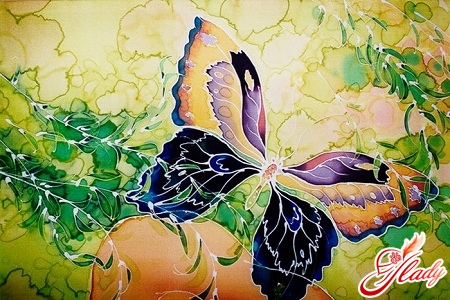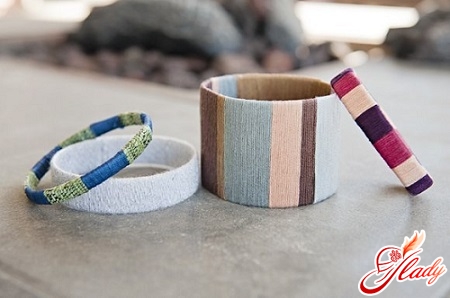 Silk painting is ancient and excitingbeautiful art. A huge selection of different paints, pigments and contours helps to create magnificent works in a variety of styles. The softness of flowing fabric, amazing play of colors - this type of handicraft cannot but captivate. It gives the opportunity to create unique and inimitable fabrics with your own hands. They can be used not only for decorative purposes, but also for creating designer products. It can be an elegant postcard, an art panel and even a delightful exclusive scarf. All these things will bring joy to both their creator and the one for whom they were intended. This technique, as a type of applied art, has a textile style. Its magnificent example is the traditional Azerbaijani hand-made scarf, which is made using an ancient technology. Products are mainly created by applying reserve lines to the fabric, which are limiters for dyes. Painting on silk, fabric - batik, is the direction that allows you to create wide patterned lines, leaving part of the fabric unpainted. Modern and traditional silk painting techniques are characterized by a combination of color spots, lines, ornaments and decorative painting. Most often, textile graphics are flat, and there is no foreground or background. In general, there are a number of decorative silk painting techniques, each of which has its own traditions.
Silk painting is ancient and excitingbeautiful art. A huge selection of different paints, pigments and contours helps to create magnificent works in a variety of styles. The softness of flowing fabric, amazing play of colors - this type of handicraft cannot but captivate. It gives the opportunity to create unique and inimitable fabrics with your own hands. They can be used not only for decorative purposes, but also for creating designer products. It can be an elegant postcard, an art panel and even a delightful exclusive scarf. All these things will bring joy to both their creator and the one for whom they were intended. This technique, as a type of applied art, has a textile style. Its magnificent example is the traditional Azerbaijani hand-made scarf, which is made using an ancient technology. Products are mainly created by applying reserve lines to the fabric, which are limiters for dyes. Painting on silk, fabric - batik, is the direction that allows you to create wide patterned lines, leaving part of the fabric unpainted. Modern and traditional silk painting techniques are characterized by a combination of color spots, lines, ornaments and decorative painting. Most often, textile graphics are flat, and there is no foreground or background. In general, there are a number of decorative silk painting techniques, each of which has its own traditions.
Equipment and materials
Usually, after looking at the magnificent works of the masters,Many people are eager to try their hand at this and take up silk painting. Such enthusiasts are interested in what is needed for silk painting. There are many devices for this technique, but you can start doing it even if you only have the most necessary equipment.
- Silk
Lightweight pongee is a great material forbeginning artists. This fabric is well suited for training exercises and samples, as well as for making holiday cards, scarves and paintings. In the process of work, as you gain experience, you can try working with other types of silk fabrics.
- Dyes and paints for silk
- Contoured mixtures and gutta
Application of lines used in silk paintingbarrier against paint spreading on fabric, is a mandatory element of this technology. Barrier lines are applied using gutta and other contour compositions.
- Thin metal attachments
There are special metal attachments that can be attached to the applicator tip to adjust the contour thickness. The attachments are available in diameters of 0.3–1.0 mm.
- Thickeners thickener
To change the way the dye spreads, special thickeners are added to the silk dye.
- Priming compound
It is applied to the fabric to change the silk's ability to absorb dye.
- Effective salts
They are used to create spectacular patterns based on changes in the texture of the design.
- Frames
For ease of painting, silk is stretched onto a frame, which facilitates correct and uniform distribution of dyes. Special sliding frames of various designs are more effective.
- Instruments
These include crampons for stretching silk on a frame, molds for colorants, flat and round brushes of different sizes, tubes for applying reserve, etc.
The basic receptions of a list
Almost all types of silk paintingare made on fabric stretched on a frame. The first and one of the main stages is the creation of a contour line. It is applied with a reserve composition, which creates a barrier and prevents the paint from spreading. To obtain a neat contour line, you need a certain skill that comes with experience. The drawing can be applied using a template or directly by hand. This is, of course, more difficult, but it gives a certain freedom of imagination, because you can show your individuality in this way. To create very interesting paintings, you can use a step-by-step application of the contour with a colorless reserve. For this, they use a reserve line, which is necessary to control the distribution of dyes and to outline the contour of the drawing. When working in this way, the lines are less noticeable, which leads to the creation of a less template and softer image. With step-by-step application of contours, the decorative role of the line is minimized. But you can create unique patterns using invisible reserve lines. With gutta, wax or water-soluble reserve, you can apply the desired pattern, and then, after painting, completely remove the contours from the finished product. To get clear geometric patterns or borders, you should learn to draw straight lines. After some practice, you can draw them by hand. To begin with, you can practice by placing a long ruler on two bars. Using thickeners for paints, a pattern can be applied to fabric using stamps and seals. Beginners can buy such auxiliary tools in a special store, where there is a fairly large selection of finished products with a variety of prints. Experienced craftsmen who create unique patterns make stamps themselves or to order.
- Painting "wet on wet" to create a watercolor effect
When using this technique, the following occurs:free flow of color. When the paint stops spreading on the fabric, a decorative layer called a "streak" is formed. If you place water streaks in certain places, you can make them part of the design. They look especially beautiful in landscapes depicting trees and mountains. In plant motifs, decorative streaks can be used to create the outlines of flower petals and leaf veins. This is a fairly complex technique, because you need to be able to control the movement of dyes.
- Work with the use of effect salts
Dry salt has the ability to absorbpaint or liquid dye, allowing you to create amazing "frost" patterns. The size of the patterned color spots can be adjusted using granules and salt crystals of different sizes. Using table salt, you can make very small dots, and using household and special effect salt for batik helps to get a larger pattern. When working in this technique, salt is scattered over the silk while the paints are still wet. Salt will not be able to absorb the dye and form a pattern if the fabric has already dried. In this case, instead of impressive flowing streaks, you will get a pattern of small stars. An unusual pattern is formed if each salt crystal has its own zone of action.
- Use of primers
Thickening agents change the abilitydye freely spread over the fabric. But you can also change the absorbency of the fabric itself. After treating silk with a special compound that prevents liquid absorption, paints are easily applied to the material even without the use of reserves. Primers are transparent or white. They are applied to the entire fabric or to a specific area. When the primer dries, the silk behaves like thick, dry paper, holding the dyes where they are applied. When working, you can adhere to the contours of the sample placed under the fabric or effectively create, following your own imagination. Applying primer mixtures gives silk some rigidity, so such products are used where softness and drapability are not very important, for example, in panels, postcards, pillowcases.
- Creation of patterns from water divorce
To create the most spectacular streaks, usesuccessive application of layers of vapor-fixing dyes, alcohol, water or solvents to dry areas of painting. Each subsequent application of dye or other liquids repels the previous layers of paint, creating so-called "wrinkled edges". If the subsequent layer is applied when the fabric is still wet, the effect obtained from the drips is softened. In this case, a pattern of lighter lines or elegant rings appears on the fabric. Here, the basic techniques of silk painting have been briefly listed, with the help of which you can create magnificent highly artistic items to decorate the interior of your home and exclusive fashion accessories for your own wardrobe. If you decide to seriously take up this fascinating business, you will also learn other additional techniques, where you will be able to work not only with smooth silk, but also with silk velvet. In the meantime, you should master the basics of the craft. And believe me, silk painting will give you true creative pleasure! We recommend reading:









